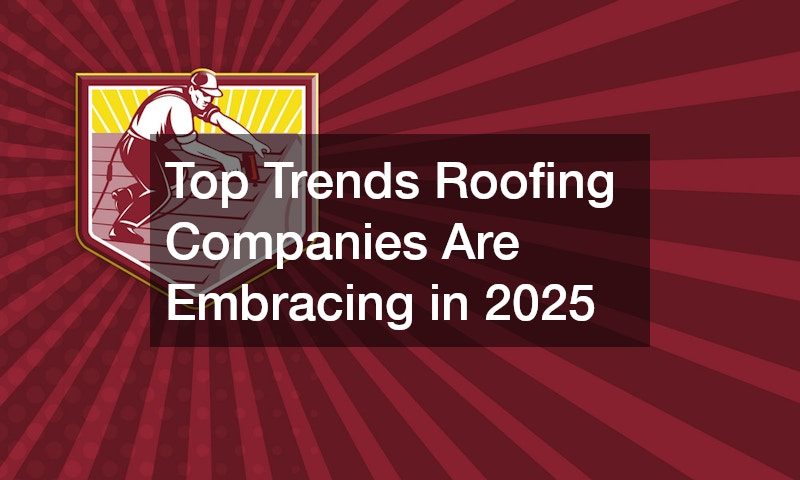The roofing industry is undergoing a significant transformation in 2025, driven by advancements in technology, evolving customer expectations, and an increased emphasis on sustainability. Roofing companies are adapting to these shifts to remain competitive, enhance service quality, and meet modern building standards. Below are the top trends shaping the future of roofing companies this year.
Embracing Sustainable Roofing Solutions
Sustainability continues to be a major focus across the construction sector, and roofing companies are no exception. Homeowners and commercial property owners alike are seeking eco-friendly options that reduce environmental impact while maintaining durability and performance.
As a result, there is growing demand for materials like recycled shingles, metal roofs, green roofs with vegetation, and solar-integrated systems.
Roofing companies are not only offering more sustainable materials but are also incorporating environmentally responsible practices in their operations. This includes reducing waste on job sites, recycling old roofing materials, and sourcing from suppliers committed to eco-conscious manufacturing.
Integration of Solar Roofing Systems
One of the most talked-about innovations in the roofing space is the seamless integration of solar technology into roofing systems. Instead of installing bulky solar panels after a roof is completed, many roofing companies now offer solar shingles or tiles that serve both as the roof covering and a power-generating surface.
This trend is gaining traction because it meets two critical needs: energy efficiency and aesthetic appeal. Solar-integrated roofing blends with the design of a home while providing long-term energy benefits, making it a highly attractive option for forward-thinking property owners.
Use of Aerial Imaging and Drones
The use of drone technology has revolutionized how roofing inspections, measurements, and damage assessments are conducted. Instead of climbing ladders or physically measuring complex roof lines, roofing companies can now deploy drones equipped with high-resolution cameras and mapping software.
Drones increase safety for workers, speed up inspection times, and produce more accurate data. This not only improves efficiency but also enhances the client experience by providing detailed visual reports and digital plans that customers can review easily.
Adoption of Smart Roofing Technology
Smart homes are no longer a novelty—they’re quickly becoming the norm. Roofing companies are responding by integrating smart roofing features into their product offerings. These include sensors embedded into the roofing system that monitor weather conditions, detect leaks, track energy efficiency, and even alert property owners to maintenance needs in real-time.
These technologies empower property owners with actionable insights and help prevent minor issues from turning into major problems. As a result, smart roofing solutions are increasingly in demand in both residential and commercial projects.
High-Performance Synthetic Materials
Another key trend is the shift toward advanced synthetic roofing materials. Traditional options like asphalt or clay are being supplemented—or in some cases replaced—by engineered materials designed to offer superior durability, weather resistance, and aesthetic flexibility.
For instance, synthetic slate and shake offer the appearance of natural materials without the weight or fragility. They are also easier to install and maintain, making them a popular choice for modern construction and renovation projects.
Roofing companies that stay ahead of material science trends are better positioned to meet the expectations of a market that values both form and function.
Enhanced Digital Customer Experience
In 2025, customers expect fast, transparent, and user-friendly service from every industry—including roofing. Leading roofing companies are improving their digital presence and streamlining communication through online scheduling tools, instant estimates, chat support, and project tracking portals.
Virtual consultations, AI-powered chatbots, and mobile apps that guide customers through every phase of the roofing process are no longer rare—they’re becoming standard. Companies that invest in these tools are not only improving efficiency but also building stronger relationships with their customers.
Focus on Resilience and Climate Adaptability
With unpredictable weather patterns and severe storms becoming more frequent, resilience is top of mind for both property owners and roofing professionals. Roofing companies are focusing more on materials and techniques that can withstand extreme weather events—be it heavy snowfall, intense heat, or high winds.
Impact-resistant shingles, waterproof membranes, and ventilation systems designed to handle sudden temperature shifts are all gaining popularity. These features are especially critical in areas prone to hurricanes, wildfires, or other environmental challenges.
Workforce Training and Safety Innovations
Labor shortages and safety concerns remain ongoing challenges in the roofing industry. In response, companies are investing in better training programs, safety gear, and jobsite technologies that protect workers and improve productivity.
Virtual reality (VR) and augmented reality (AR) are now being used to train roofing crews, offering hands-on learning in a risk-free environment. Wearable tech such as smart helmets and harnesses that monitor worker vitals and posture are also helping reduce workplace injuries.
By prioritizing safety and skill development, roofing companies are building stronger teams capable of delivering high-quality work in a fast-changing industry.
As the roofing industry continues to evolve, staying ahead of these trends is essential for long-term success. From sustainable practices and solar integration to smart technology and digital customer service, today’s leading roofing companies are those that embrace innovation and adapt to the needs of modern property owners.
Whether you’re a homeowner planning a new roof or a contractor exploring the latest techniques, understanding these trends will help you make informed decisions and align with the best practices of 2025.


